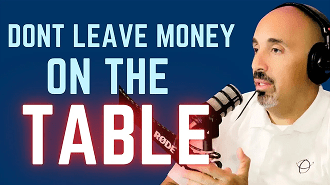Retirement planning involves more than just diligently saving money over the years; it also requires a strategic approach to managing taxes to maximize your financial security during retirement. The type of accounts where you invest your hard-earned dollars can significantly influence how much of your money you actually get to enjoy during your retirement years. At BAM Advisory Group, we specialize in helping our clients understand tax-efficient strategies, with a particular focus on what we call the “Tax Triangle.”
Without a clear tax strategy, you might be surprised at how quickly taxes can erode your retirement savings. To help you optimize your retirement income, we’ll break down the Tax Triangle, explain how it works, and demonstrate how leveraging this framework can help you reduce your tax liabilities. For a more in-depth explanation, be sure to check out our YouTube video on mastering the Tax Triangle.
Understanding the Tax Triangle: A Comprehensive Framework
The Tax Triangle is a powerful model designed to help you understand how different retirement accounts are taxed. By understanding the Tax Triangle, you can make more informed decisions about where to allocate your investments, how to plan for distributions, and how to optimize your tax strategy throughout your retirement years.
The Tax Triangle consists of three sides, each representing a different type of account:
- Taxed Always (Taxable) Accounts
- Taxed Later (Tax-Deferred) Accounts
- Tax-Free Accounts
- Annual Taxation: At the end of each year, you will receive a 1099 tax form for any gains or income earned. This means you’ll be required to report your earnings to the IRS and pay taxes accordingly.
- Ordinary Income vs. Capital Gains: If you earn dividends or interest, you’ll pay taxes at your ordinary income tax rate. However, if you sell investments that have appreciated, you may qualify for the lower long-term capital gains rate if you’ve held the investment for over a year.
- Short-Term Focus: These accounts are most beneficial for investments where you may need quick access to cash. However, they are less optimal for long-term tax efficiency.
- Hold Investments Long-Term: By holding investments for more than a year, you can take advantage of the lower long-term capital gains tax rates, which are often much lower than ordinary income tax rates.
- Invest in Tax-Efficient Funds: Consider investing in index funds or Exchange-Traded Funds (ETFs) that have lower turnover and fewer taxable distributions.
- Utilize Tax-Loss Harvesting: This strategy involves selling investments that have declined in value to offset capital gains on appreciated investments, potentially reducing your tax bill.
- Required Minimum Distributions (RMDs): Once you reach age 73, you are required to start taking distributions from these accounts. These RMDs are considered taxable income and could push you into a higher tax bracket.
- Potential Tax Burden: If most of your savings are in tax-deferred accounts, you may face a substantial tax burden in retirement. This can also reduce your eligibility for other benefits, such as Medicare premiums and Social Security.
- Roth Conversions: Consider gradually converting funds from tax-deferred accounts into Roth accounts. By doing so, you can pay taxes now at current rates rather than potentially higher rates in the future.
- Strategic Withdrawals: Plan your withdrawals carefully to avoid being pushed into higher tax brackets. For instance, during years when your income is lower, consider taking additional distributions to take advantage of lower tax rates.
- Collaborate with a Financial Advisor: At BAM Advisory Group, we help clients develop tailored strategies to minimize taxes on their retirement savings. Reach out to us for a personalized assessment.
- After-Tax Contributions: Contributions are made with money that has already been taxed, so qualified withdrawals are tax-free.
- Qualified Withdrawals: To enjoy tax-free distributions, you must be at least 59½ years old and have held the account for at least 5 years.
- No RMDs: Unlike traditional retirement accounts, Roth IRAs are not subject to Required Minimum Distributions, making them an excellent tool for estate planning.
- When to Consider Roth Conversions: If you’re currently in a lower tax bracket than you expect to be in retirement, a Roth conversion can be beneficial. It allows you to pay taxes now at lower rates.
- Strategic Timing: Converting portions of your tax-deferred accounts each year can prevent a massive tax hit all at once. By spreading out your conversions, you can stay within a favorable tax bracket.
- Roth Contributions: These are subject to income limits. If you earn too much, you may not be eligible to contribute directly to a Roth IRA.
- Roth Conversions: Unlike contributions, Roth conversions have no income limits, making them a powerful tool for high-income earners who want to reduce their tax burden in retirement.
- Prioritize Tax Diversification: Ensure that your retirement portfolio includes a mix of taxable, tax-deferred, and tax-free accounts to give you flexibility in retirement.
- Plan Withdrawals Strategically: Work with a financial advisor to plan your withdrawals in a way that minimizes your tax liabilities and maximizes your retirement income.
- Model Future Tax Scenarios: At BAM Advisory Group, we use sophisticated modeling tools to project the impact of various tax strategies. Schedule a consultation to learn more.
- Reduce Lifetime Tax Liability: Strategies like Roth conversions and tax-efficient withdrawals can help you minimize the taxes you pay throughout your retirement.
- Maximize Retirement Income: Properly managing your accounts ensures you have a sustainable income stream that lasts throughout your retirement.
- Protect Your Legacy: By strategically planning your tax situation, you can leave a more substantial financial legacy for your heirs.
- Schedule a consultation to discuss your tax strategy.
- Watch our YouTube video for deeper insights into the Tax Triangle.
- Explore our Retirement Planning Resources for more guides and tools.

